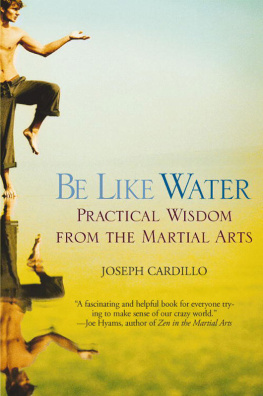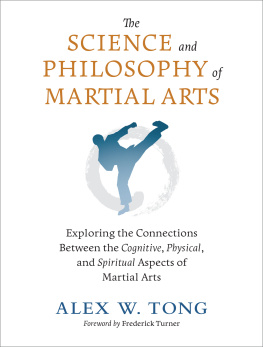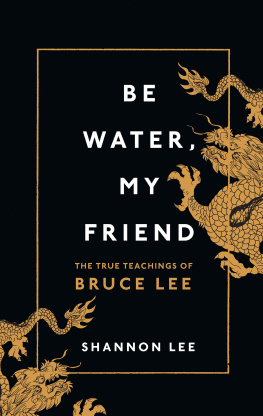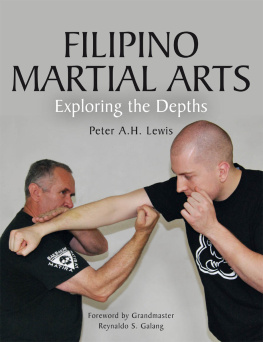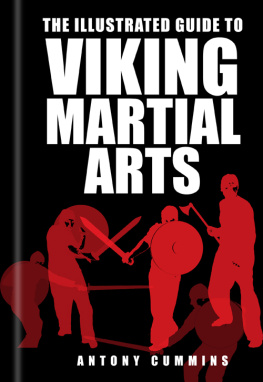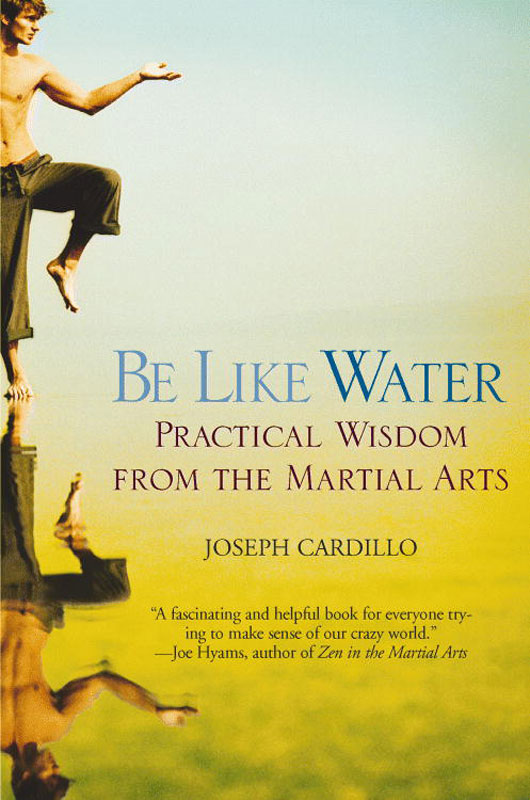Copyright 2003 by Joseph Cardillo
All rights reserved.
Warner Books
Hachette Book Group
1271 Avenue of the Americas
New York, NY 10020
Visit our Web site at www.HachetteBookGroup.com
First eBook Edition: September 2003
Warner Books and the W logo are trademarks of Time Warner Inc. or an affiliated company. Used under license by Hachette Book Group USA, which is not affiliated with Time Warner Inc.
ISBN: 978-0-446-55462-6
PRACTICE GOING WITH THE FLOW
BE PRESENT, BE CONFIDENT,
BE SPONTANEOUS, AND BE FREE.
ABOVE ALL, BE LIKE WATER.
With this illuminating volume, youll learn to:
pace yourself
conquer fear
overcome force with softness
follow your bliss
channel your energy
free your mind of anger, fear, guilt, and hatred
safeguard strength
gain self-respect
and much more.
Drawing from his basis in the martial arts, Joe Cardillo guides the reader through an exciting passageway of new discoveriesultimately leading to a more refined method of encountering and interacting with life.
Scott Shaw, author of Nirvana in a Nutshell and The Warrior Is Silent: Martial Arts and the Spiritual Path
Delivers ancient tools for living well. This book will teach you how to walk in the world like a martial arts master.
Fred Miller, author of How to Calm Down
For my wife, Elaine, and our household of little creatures: Mignonne, Russ, Sharona, Jolie, Albinoni, Celia, and Elsa
I wish to thank my immediate and extended family for their energies and guidance in helping to bring this project to completion. I further wish to express my gratitude to all my martial arts associates, partners, and colleagues for their support, brotherhood, and sisterhood along this dazzling journey.
Special thanks are extended to Doreen and Barry Bedaw, Alfio and Josephine Cardillo, Alfred and Cathy Cardillo, Maria and Christopher Conover, Molly Chehak, Elaine McHenry, Eleanor McHenry, Matthew Papa, and Michelle Tessler.
And to everyone around the world who believes in the infinite potential of life and spirit.
M ore than 70 percent of the earths surface is water. Every living thing is composed of water, and we all need it to survive. Water is a symbol of purity, birth, and rebirth. When you embody the characteristics of this life-giving force, you are going with the flow. You fill every moment with living, you force nothing, you become, you experience, you interrelate. In going with the flow, you become tranquil and peaceful. Ideally, we strive to always and everywhere be like waterfor water is gentle, and yet it is powerful. It can be still or in motion. It can absorb. It can go over, under, around, and through things. It can dissolve things, float them, or float atop them. It can become hot, cold, heavy, light, invisible, solid, or vapor. It is formless, yet it can adapt to any container. In these pages, you will discover how to become like water. This book is about remaining yourself in an ever-changing world and retaining your sanity in a world full of absurdity. Simply put, its about going with the flow. Going with the flow is the martial artists way.
Though martial arts began with the development of language itself and can be traced back more than three thousand years in China, it wasnt until thousands of years later that these combat disciplines fused with philosophy. In A.D. 525, a Buddhist monk from India named Bodhidharma visited the Shaolin Temple of China. What he found was that the monks were deficient both spiritually, in terms of depth and awareness, and physically, in that they could not defend themselves against assailants. Their vulnerability disturbed him greatly.
Consequently, he taught them meditation, breathing, and a host of tenets leading to a deeper, more enlightened way of life. He also taught a regimen of exercises taken from the movements of animals, to incorporate into their daily routine. In time, this intense study evolved into an advanced martial arts system known as Kung Fu. Many believe, to this day, that Kung Fu is the core of all martial arts as we presently know them.
Bodhidharmas teachings piloted martial arts from a one-dimensional exploration of combat into a holistic discipline for the strengthening of body, mind, and spirit. Although the element of combat was still significant, the monks who had been trained to avoid conflict were never attackersrather, they used their skills to help them carry out their work as caretakers and healers.
In the mid-nineteenth century, when the need for fighting skills in the Orient diminished, the focus of martial arts shifted from developing the body for battle to the development of mind and spirit. In fact, it was during this time in history that the word do (which means the way) was added to many martial arts styles. Some examples of this are:
Kendo: way of the sword.
Judo: gentle way.
Tae Kwon Do: way of the hand and foot.
Aikido: harmony spirit way.
Kyudo: way of the bow.
Bushido: way of the warrior.
Karate-do: empty-hand way.
The martial artists training now emphasized personal and spiritual development: living a better life; becoming a better parent, friend, and human being. Combat maxims were replaced with ideals of self-actualization and welfare, along with axioms such as Maximum benefit with minimum effort (or stressors).
Martial arts became more about conquering the inner self than about winning a fight. Martial artists were taught loyalty, sincerity, brotherhood, sisterhood, never to retreat, and to look at death unflinchinglyall in the hope of creating a better, freer, longer existence, with the possibility of enlightenment (which involved the transcendence of consciousness beyond their own bodily limitations). Students were taught many ways and means to serve those ends and encouraged to do what worked, not what was dictated by a culture. They were taught mushin, which means to empty the mind of guilt, doubt, fear, hatred, and other negative emotions that only get in the way of achievement (or, for the warrior, in the way of winning the fight). They learned ways to increase and develop chi (internal life energy) on their path toward self-realization, healing, and power. And they were taught to hand down their wisdom to the next generation.
One thing I have learned in my own quest for a deeper and fuller life is that there are many voices of knowledge: philosophical, theological, scientific, athletic, artistic, and more. No one discipline is better than the others. For me, the study of martial arts has been one of the most immediately applicable and successful. In this spirit, I hope to unravel and share some of that knowledge with you. It doesnt matter whether you are a practicing martial artist or not; anyone and everyone can apply the principles in this text.
The process of learning to nurture ourselves with clean, positive energy is a riveting one. You will literally feel your body chemistry cleansing itself. You will think more clearly. You will feel more deeply. You will gain confidence in your ability to take care of yourself. Many amazing things will likely occur. I wish you a warm heart and a joyful soul, strength, and beauty in all the days ahead.
How to Use This Book
Be Like Water is not a how-to guide to performing fighting techniques. It is, rather, a simple study of philosophies within and throughout the martial arts, for the purpose of self-improvement and spiritual development. My aim is embedded in the origins of martial arts thinking, and that is: to put the heart of the martial arts into your own heart so you may return your spirit to its primal state of spontaneity, allowing you to live a fuller and freer life.

